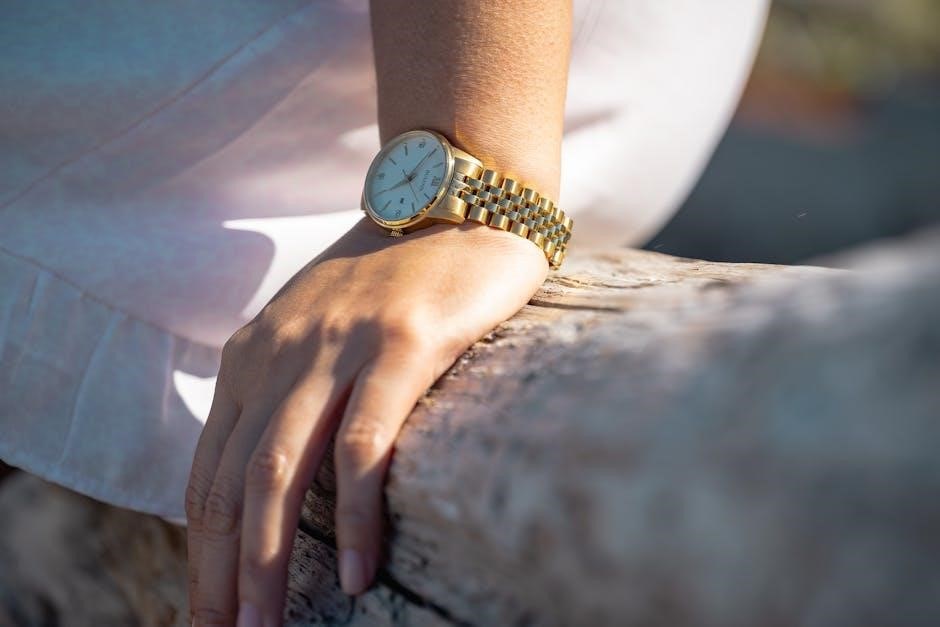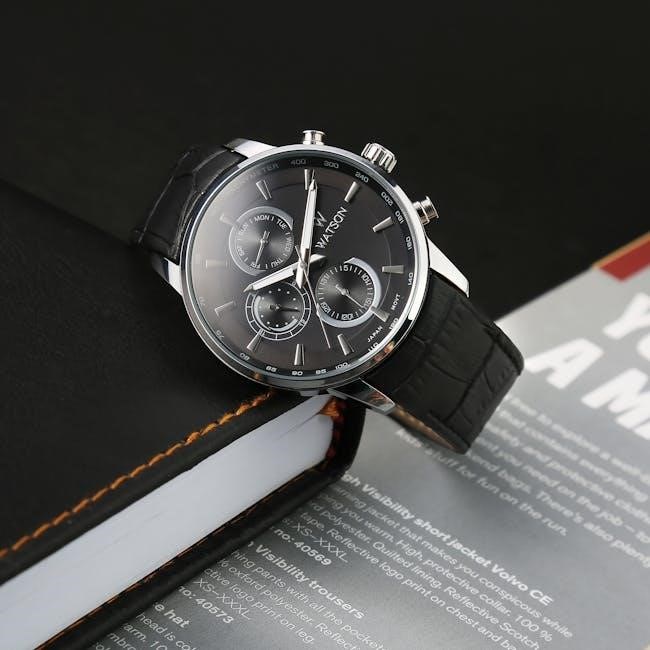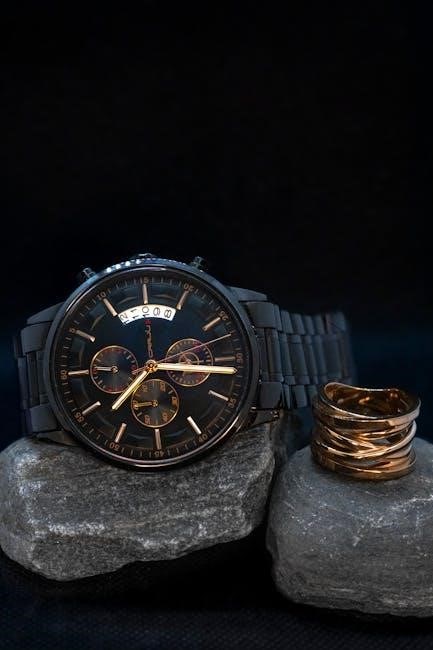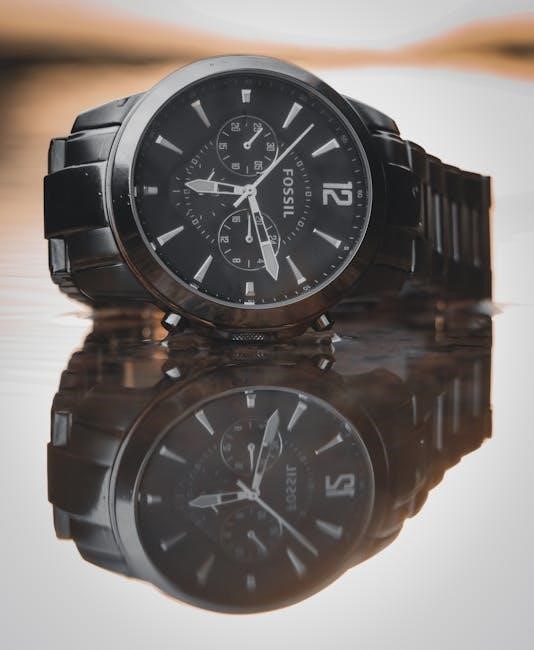A watch band size guide helps ensure a perfect fit, combining style and comfort. Proper measurements are essential for both width and length, guaranteeing optimal wearability and durability.
1.1 Overview of Watch Band Sizing
Watch band sizing is crucial for ensuring a comfortable and secure fit. It involves measuring two key dimensions: the width of the band where it attaches to the watch (lug width) and the total length of the strap. The lug width is measured in millimeters and varies depending on the watch case size. Standard lengths for watch bands differ between men and women, typically ranging from 165mm to 180mm for women and 184mm to 197mm for men. Accurate measurements ensure the band is neither too tight nor too loose, providing optimal wearability. Proper sizing also depends on the material, such as leather, metal, or nylon, as each has specific fitting characteristics. Using a ruler or flexible measuring tape is essential for precise measurements, while online size charts and tools can further guide the process for a perfect fit.
1.2 Importance of Proper Fit

A proper fit is essential for both comfort and functionality. A watch band that is too tight can cause discomfort or even restrict blood flow, while one that is too loose may shift excessively or slip off. Correct sizing ensures the watch stays securely in place, allowing features like heart rate monitoring to function accurately. Additionally, a well-fitted band prevents wear and tear, extending the lifespan of the strap. For specific styles, such as Apple Watch Solo Loops, the fit is critical for the stretch-fit design to work effectively. Proper fit also enhances the overall aesthetic, making the watch look more proportionate on the wrist. Ensuring the right size is especially important for materials like leather, which may stretch over time, and for metal bands, which can be adjusted for precise comfort.
Measuring Your Watch Band Width
Measure the distance between the watch lugs in millimeters (mm) using a ruler or caliper. Lug width is crucial for selecting the correct strap size.
2.1 Understanding Lug Width
Lug width refers to the distance between the lugs—the points where the watch band attaches to the watch case. Accurate measurement ensures compatibility with the strap. Using a ruler or caliper, measure the inside of the lugs in millimeters. Common widths range from 18mm to 24mm, with 20mm being standard for many men’s watches. Proper lug width ensures a secure, balanced fit. Incorrect sizing can lead to a loose or tight strap. Always measure precisely for optimal comfort and functionality. This measurement is critical when selecting a replacement band. Ensure the strap’s width matches the lug width for a seamless fit. This simple step guarantees style and durability; Always double-check measurements for accuracy.
2.2 How to Measure Lug Width
To measure lug width, place the watch face down and position a ruler or digital caliper between the inner edges of the lugs. Ensure the tool is aligned straight for accuracy. Record the measurement in millimeters, as this is the standard unit for watch bands. For curved or irregular lug shapes, use a flexible measuring tape to fit snugly between the lugs. Alternatively, a spring bar tool can help gauge the space. Always measure from the inside of the lugs to avoid including the watch case in the measurement. This ensures the strap fits securely without overlapping or gapping. Double-check the measurement to confirm accuracy, as even a small discrepancy can affect the fit. Proper lug width measurement is crucial for selecting the correct watch band size.
2.3 Standard Watch Band Widths
Standard watch band widths typically range from 16mm to 24mm, with 20mm being the most common size for men’s watches. Women’s bands often range from 14mm to 18mm. The width is determined by the distance between the watch lugs, measured in millimeters. For example, a 20mm band fits a watch with 20mm lug width. Some bands taper slightly, but the width at the lugs remains the standard reference point. Choosing the correct width ensures a seamless fit and prevents the band from slipping or appearing mismatched. Always refer to the manufacturer’s specifications or use a ruler to confirm lug width for accurate sizing. Proper width alignment enhances both comfort and aesthetics, making it essential for a polished look.
2.4 Tools Needed for Measurement
To accurately measure your watch band width, you’ll need a few essential tools. A ruler or digital caliper is ideal for precise millimeter measurements between the watch lugs. For wrist circumference, a flexible measuring tape ensures a snug fit. Additionally, a spring bar removal tool can help detach the band for easier measurement. Some guides recommend using a printed size chart or template to compare and verify measurements. For leather or fabric bands, a ruler or seam measure can be used to determine the width accurately. Proper tools ensure precise sizing, preventing errors and ensuring a comfortable, secure fit. Always use high-quality tools to avoid damaging your watch or band during measurement; These simple tools make the process straightforward and reliable for achieving the perfect fit.

Measuring Watch Band Length
Accurate watch band length measurement ensures a comfortable fit. Use a flexible tape to measure around your wrist, ensuring snugness. Standard lengths range from 165mm for women to 197mm for men.
3.1 Understanding Band Length
Band length refers to the total length of the watch strap, including both ends. Proper length ensures the watch sits comfortably on the wrist, neither too tight nor too loose. Standard lengths vary by material and brand, with leather, metal, and rubber straps having specific sizing guidelines. For women, standard lengths typically range from 165mm to 180mm, while men’s straps range from 184mm to 197mm. Accurate measurement involves wrapping a flexible tape around the wrist and recording the snug circumference. This ensures the strap aligns with the watch case size and personal comfort preferences, making it essential for a perfect fit. Using a tape measure or a printable guide can help determine the ideal length for any wrist size or watch style.
3.2 How to Measure Band Length
To measure the band length accurately, start by wrapping a flexible measuring tape snugly around your wrist at the point where you normally wear your watch. Ensure the tape is not too tight or too loose. Record the measurement in millimeters or inches. For existing straps, place the watch band flat and measure the total length from end to end, excluding the buckle or clasp. Use a ruler or caliper for precise results. If unsure, a printable size guide or online calculator can help determine the ideal length based on wrist circumference. Proper measurement ensures the watch sits comfortably, with the band neither overlapping nor leaving excessive gap. This step is crucial for selecting the right size, especially for leather, metal, or rubber straps, which have specific length requirements for a perfect fit.
3.3 Standard Watch Band Lengths
Standard watch band lengths vary by material and intended use. For men, typical lengths range between 184mm and 197mm, while women’s bands are generally shorter, measuring 165mm to 180mm. Metal bands often come in adjustable sizes, allowing customization to fit individual wrist sizes. Leather and nylon straps may be available in fixed lengths, requiring precise measurement to ensure comfort. Rubber and sport bands tend to offer universal sizing, designed to accommodate a wide range of wrist sizes. When selecting a band, consider both the material and intended use to choose a length that provides a snug yet comfortable fit. Proper length ensures the watch sits securely without restricting movement, enhancing both style and functionality. Always refer to the manufacturer’s size chart for specific guidance, as variations may exist between brands and models.
3.4 Tools for Accurate Length Measurement
Accurate measurement of watch band length requires the right tools. A flexible measuring tape is ideal for wrapping around the wrist to determine the perfect fit. Alternatively, a ruler or caliper can be used to measure the band’s length directly. For leather or fabric straps, measuring from the buckle to the farthest hole ensures proper sizing. Metal bands often require a spring bar tool to remove and measure the links. Digital calipers provide precise millimeter measurements, especially for tapered bands. If unsure, printable length charts or paper templates can help simulate the fit. Always ensure the tool is snug but not overly tight, as this affects comfort and accuracy. Using the correct tools ensures a precise measurement, making it easier to select the right size for a comfortable and secure fit.

Watch Band Size Chart
A watch band size chart provides standard widths and lengths, helping determine the perfect fit. It includes measurements in millimeters and inches for various wrist sizes, ensuring accuracy and comfort.
4.1 Width and Length Chart
The width and length chart serves as a comprehensive guide, detailing standard measurements for watch bands. Width is typically measured in millimeters between the watch lugs, with common sizes ranging from 18mm to 24mm for men and 14mm to 18mm for women. Length is measured in millimeters as well, with options varying from 165mm for smaller wrists to over 220mm for larger ones. This chart helps users match their wrist size to the appropriate band dimensions, ensuring a comfortable and secure fit. By referencing the chart, individuals can easily determine the ideal width and length for their watch band, whether it’s for a leather, metal, or rubber strap.
4.2 How to Use the Chart
Using the watch band size chart is straightforward. First, measure your wrist circumference using a flexible tape measure or a printable tool. Next, determine your watch’s lug width by measuring the distance between the lugs in millimeters. Refer to the chart to find the corresponding band width and length. For example, if your wrist measures 180mm, a standard band length for women would be 165mm-180mm, while men’s bands range from 184mm-197mm. Ensure the band type (leather, metal, or rubber) matches your watch’s style. If converting units, use the chart’s millimeter-to-inch conversion guide. Accurate measurements ensure a comfortable, secure fit. Always cross-reference your wrist size with the chart to select the ideal band size for your watch.
4.3 Converting Millimeters to Inches
Converting millimeters to inches is essential for ensuring your watch band fits perfectly. To convert, divide the millimeter measurement by 25.4. For example, a 20mm band width equals approximately 0.787 inches. This conversion helps match international sizing standards, making it easier to choose the right band. Always refer to the chart for precise conversions, as slight variations can affect fit. Accurate unit conversion ensures compatibility between your watch and band, guaranteeing both comfort and style. Use this guide to seamlessly adapt measurements for a flawless fit.

Material-Specific Size Guides
Explore size guides tailored to metal, leather, nylon, and rubber bands. Each material has unique sizing considerations to ensure the perfect fit for your watch.
5.1 Metal Watch Bands
Metal watch bands are durable and adjustable, offering a sleek look. Sizes range from 18mm to 24mm in width, with standard lengths for men and women. Adjustability ensures a snug fit.
5.2 Leather Watch Bands
Leather watch bands offer a classic, sophisticated style. Available in widths from 18-24mm, they cater to various wrist sizes. Lengths range from 165mm-180mm for women and 184mm-197mm for men, ensuring a comfortable fit.
5.3 Nylon and Rubber Watch Bands
Nylon and rubber watch bands are popular for their durability and flexibility. These materials are ideal for sports or casual wear, offering a lightweight and moisture-resistant design; Nylon bands often feature a textured surface for improved grip, while rubber bands provide a soft, comfortable feel. Both materials are available in standard widths, typically ranging from 18mm to 24mm, and lengths that cater to various wrist sizes. Nylon bands may have adjustable straps for a one-size-fits-all approach, while rubber bands often come in fixed lengths. To ensure the best fit, measure the width between the watch lugs and select a length that matches your wrist size. These bands are versatile and easy to maintain, making them a practical choice for everyday use or active lifestyles. Proper sizing ensures comfort and a secure fit.

Strap Attachment Styles
Strap attachment styles vary, including spring bars, buckles, and clasps; Each style ensures secure fastening, enhancing both comfort and functionality. They cater to different preferences and wrist sizes effectively.
6.1 Spring Bar Attachment
The spring bar attachment is a common method for securing watch bands. It uses small metal pins that expand when pressed, allowing the band to be slid onto the watch. This system is durable and easy to use, providing a snug and secure fit. Spring bars are widely used in both metal and leather straps due to their reliability and simplicity. They are also easy to replace, making them a popular choice among watch enthusiasts. Proper installation ensures the band stays in place, offering both style and functionality. This attachment style is versatile, suitable for various watch types and materials, ensuring a seamless integration with the timepiece’s design. It is a preferred option for its ease of use and robust performance.
6.2 Buckle and Clasp Attachments
Buckle and clasp attachments are popular mechanisms for securing watch bands, offering both functionality and style. A buckle typically features a prong or tang that fits into holes along the strap, providing adjustable closure. Deployant clasps, on the other hand, are hinged mechanisms that open and close with a button or lever, offering convenience and a sleek appearance; Both designs ensure a secure fit, with the clasp or buckle holding the band firmly in place. These attachments are commonly found on leather, metal, and nylon straps. The choice between a buckle and clasp often depends on personal preference and the watch’s aesthetic. High-quality buckles and clasps are durable and designed to withstand daily wear, making them a practical choice for various watch styles. Proper alignment and adjustment are key to ensuring a comfortable and secure fit.

Pro Tips for Accurate Measurements
Use a flexible measuring tape snugly around your wrist for precise band length. Ensure the tape isn’t too tight or loose for optimal comfort and fit.
7.1 Using a Flexible Measuring Tape
A flexible measuring tape is essential for accurately determining your wrist size, ensuring a comfortable and secure fit for your watch band. To use it effectively, wrap the tape around the part of your wrist where you normally wear your watch, making sure it’s snug but not overly tight. This will give you a precise measurement to guide your band size selection. For the best results, align the tape horizontally and avoid twisting it; Once you have your wrist measurement, you can compare it to standard watch band length charts to find the ideal fit. This method works for all types of watch bands, including metal, leather, and nylon straps, ensuring a seamless and tailored look for your timepiece.
7.2 Ensuring a Comfortable Fit
Achieving a comfortable fit is crucial for both functionality and style. After measuring your wrist and selecting the appropriate band size, ensure the watch sits snugly without restricting movement. For metal bands, adjust the links to fit your wrist perfectly, removing or adding links as needed. Leather and nylon straps should be adjusted to the closest hole that provides a secure yet comfortable fit. Avoid overtightening, as this can cause discomfort or irritation. Additionally, consider the thickness of the watch case and how it interacts with the band’s width and style. A well-fitted watch band enhances wearability, making it suitable for daily use or special occasions. Always test the fit by wearing the watch for a short period to ensure there’s no discomfort or pinching, allowing you to enjoy your timepiece with confidence and ease.

Apple Watch Band Size Guide
Apple Watch bands offer tailored fits using precise measurement tools. Utilize Apple’s size chart or printable guide to ensure your band fits comfortably and securely, enhancing your wearable experience.
8.1 Solo Loop Size Guide
The Solo Loop band offers a seamless, clasp-free design, requiring precise wrist measurement. Available in nine sizes, it stretches over the wrist for a snug fit. To determine your size, use Apple’s official chart or printable tool, ensuring comfort and security. Measure your wrist accurately, as the Solo Loop fits without adjustments. This band is ideal for those seeking a streamlined look without buckles or clasps. Proper sizing ensures optimal comfort and functionality, making it a popular choice for Apple Watch users. By following the guide, you can easily find the perfect fit tailored to your wrist size, enhancing your overall Apple Watch experience with style and convenience.
8.2 Sport Band Size Guide
The Sport Band is a popular choice for its durability and comfort. To find the right size, measure your wrist using a flexible tape or the Apple size guide. Wrap the tape snugly where the watch sits, ensuring it’s not too tight or loose. Standard lengths for Sport Bands are categorized into small, medium, and large, accommodating wrist sizes from 5.5 to 8.7 inches. The Sport Band’s design allows for adjustable closure, offering a secure fit. Proper sizing ensures all-day comfort and optimal performance. Use Apple’s official sizing tool or printable guide to determine your exact size, ensuring the band aligns with your wrist circumference for the best fit and functionality.
Mastering watch band sizing ensures a perfect fit. Use precise tools and guides to determine your ideal size, guaranteeing comfort, style, and long-lasting durability for your timepiece.
9.1 Summary of Key Points
9.2 Final Tips for Perfect Fit
To achieve a perfect fit, ensure your watch band is snug but not restrictive. Use a flexible measuring tape for accurate wrist measurements, and consider your wrist shape and daily activities. For Apple Watch users, utilize the official size chart or try on bands in-store. When ordering online, double-check the seller’s size guide and return policies. Metal bands can often be adjusted, while leather and nylon bands may require precise sizing. If unsure, opt for a slightly longer length, as it can usually be shortened. Remember, a well-fitting band enhances comfort and prolongs the life of your watch. Always prioritize quality materials and secure attachments for a polished, long-lasting wear.



